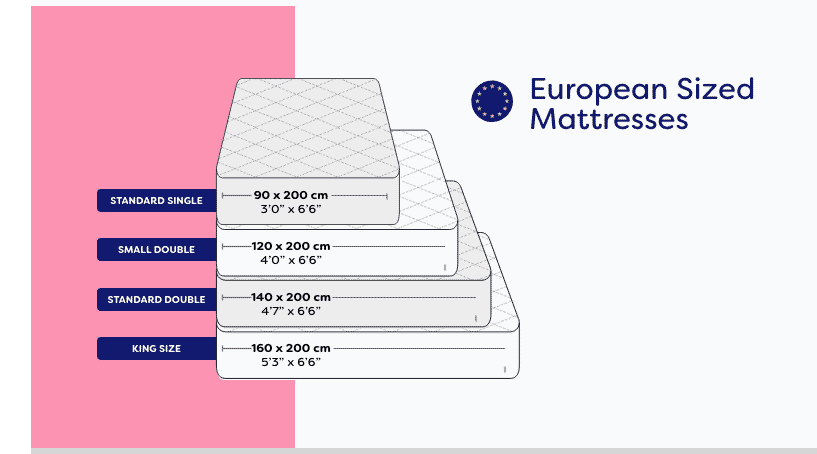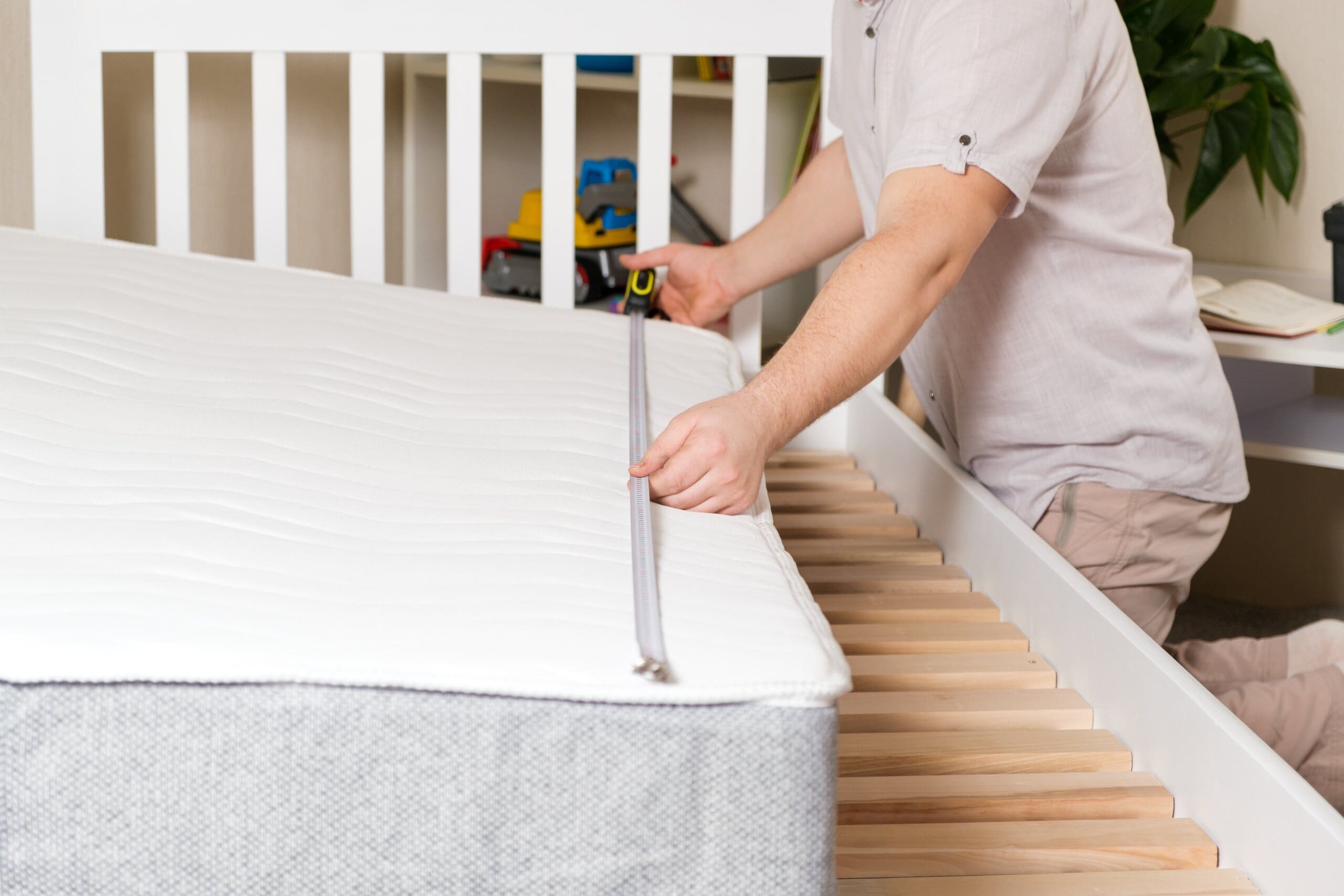Last updated: November 2025
Ultimate Uk Bed And Mattress Size Guide
Discover everything you need to know about mattress and bed sizes and dimensions, ranging from small singles to super kings, as well as tips on how to measure up correctly.
Whether you're furnishing your guest room, redecorating your master bedroom, or buying your child's first bed, selecting the right size for your bed and mattress requires serious consideration. As you'll soon discover, there's far more that goes into choosing the correct bed size than simply sleeping space.
A perfect-sized mattress will not only give you plenty of room to stretch out but also won't take up too much space in your bedroom. On top of this, you'll also need to consider who else is sharing the bed with you, whether that's a partner, children, or even your pets!
Put simply, there is a lot you should consider when choosing a new mattress or bed frame, which is exactly why we've created this detailed UK bed and mattress size guide to help you out. Covering all the essential information you need, our bed and mattress size guide goes over everything from the basic measurements of each mattress type, to what measuring considerations to take into account - all to make your selection process as simple as possible.
What are the standard UK bed and mattress sizes?
Like in Europe and America, standard UK bed sizes vary according to several key metrics. We’ve outlined the basic dimensions of UK beds and mattresses below, including both metric and imperial measurements:

| Bed/Mattress Size | Dimensions (Metric - CM) | Dimensions (Imperial - Feet & Inches) |
| Small Single | 75 x 190 cm | 2’6” x 6’3” |
| Standard Single | 90 x 190 cm | 3’0” x 6’3” |
| Small Double | 120 x 190 cm | 4’0” x 6’3” |
| Standard Double | 135 x 190 cm | 4’6” x 6’3” |
| King Size | 150 x 200 cm | 5’0” x 6’6” |
| Super King Size | 180 x 200 cm | 6’0” x 6’6” |
You should also bear in mind that UK kids’ beds and mattress sizes, such as cot and cot bed mattresses, can come in different sizes as well:
| Cot Mattresses | 120 x 60cm or 47" x 23" |
| Cot Bed Mattresses | 140 x 70cm or 55" x 27" |
Is bed size the same as mattress size?
For the most part, especially in the UK, internal bed frame measurements will directly correspond to the same mattress size. So, a small double bed frame will have the same internal dimensions as a small double mattress – though externally it will be slightly wider and longer.
Therefore, if you want to know exactly what size bed you can fit in your room, you should take a look at individual external bed frame dimensions, as they can differ between manufacturers and designs.
What do you need to know about different UK bed and mattress sizes?
Having given you a brief overview of what the different standard UK bed sizes are, let’s now look at each size of mattress in more detail to give you a better idea of their specific measurements, and which sleepers they’re most suitable for:
What size is a small single bed and mattress?
Size: 75 x 190cm or 2’6” x 6’3”
Best for: children and small bedrooms with multiple beds
Aside from cots and bed designs orientated towards babies, small single mattresses are typically the smallest mattresses on the market. Younger children often prefer the cosier feel of a small single, so they’re a popular choice for kids who are just starting to sleep alone.
Of course, they’re also made for smaller bedrooms or those instances in which you need to fit more than one bed in a room, like in a caravan. Bunk beds aren’t always a practical choice, so small singles allow you to put two kids into a bedroom without compromising too much of the floor space.
What size is a single bed and mattress?
Size: 90 x 190cm or 3’0” x 6’3”
Best for: children and teenagers
The standard single mattress size in the UK, small mattresses may seem lacking in space when compared to doubles and king-size beds, but there’s still enough room for a fantastic night’s sleep. Standard singles are typically chosen for box rooms, guest rooms, and any bedrooms where floor space is prized more than sleeping space.
Single-size mattresses are also well-suited to children’s bedrooms, particularly younger kids without big, open beds. They’ll provide you with years of comfort, and good models are built to last, so they’re a wonderful investment if you’re happy with their relatively small dimensions.
What size is a small double bed and mattress?
Size: 120 x 190cm or 4’0” x 6’3”
Best for: teenagers, single sleepers, and couples who like to cuddle up
The small double bed is the standard double’s versatile, space-saving, smaller sibling. It’s designed for rooms that are shorter on space and will fit in most master bedrooms and spare rooms without issue. If you’re a couple, you’ll be sleeping closer together, but there’s still plenty of room – as long as neither of you are nocturnal fidgeters.
Small double mattresses are a good choice if you’re worried that larger models will leave you without any space to move around the bedroom. They’re basically the perfect intermediary stage between the classic single and a larger double bed size or king-size bed, allowing you to stretch out and make yourself comfortable, without dangling off the edges.
What size is a double bed and mattress?
Size: 135 x 190cm or 4'6" x 6'3"
Best for: couples and guest rooms
A standard double bed is the most popular bed and mattress size in the UK. This is largely down to the fact that it fits in most bedrooms and offers a significant amount of sleeping space. This makes it a great choice if you’re concerned with over-cluttering or would like to add more furniture to the bedroom.
The standard double mattress size is also regularly found in guest rooms, which are generally a little smaller than master bedrooms. And as they’re used less regularly, beds in guest rooms don’t need to be as large. However, they’ve still got to be comfortable, so a double bed size helps strike the balance perfectly.
What size is a king-size bed and mattress?
Size: 150 x 200cm or 5'0" x 6'6"
Best for: couples that want added sleep space but don’t have the room for a super king
King-size mattresses are a perfect compromise if you’re looking for a large amount of sleeping space but can’t quite fit a super king-size in the bedroom. They’re ideal if you’re on the tall side or share the bed with a restless partner. And their extra legroom will let you stretch out and get comfy – which is absolutely essential for a good night’s sleep.
Many people struggle to decide between a king-size or standard double, but we reckon it’s a pretty simple choice. If your bedroom is big enough for UK king-size bed dimensions, the extra space it offers is definitely worth it. The additional 10cm in length and 15cm in width may not sound like a lot, but it makes an enormous difference to your night’s sleep.
What size is a super king bed and mattress?
Size: 180 x 200cm or 6'0" x 6'6"
Best for: those who want the ultimate in terms of sprawl-out space, or often have kids and pets join them in bed.
If having plenty of sleeping space is the most important factor in your decision, a super king-size bed is the way to go. The biggest UK bed size on offer, the dimensions of a super king allow you to really spread out, making this bed ideal if you’re a couple who value having enough room to wriggle and move about without impacting each other’s sleep.
If you’re considering a UK super king-size mattress, be aware that you’ll need plenty of floor space, particularly if you want to fit in furniture around it. Again, this is the biggest UK bed size type available in most cases, and its large size means it makes quite an impact on how your bedroom looks!
European bed & mattress sizes
So far in our bed size guide, we’ve been explaining mattress sizes in UK-specific terminology to avoid any potential confusion in size disparities. But, with that being said, there are some differences between European bed and mattress sizes (mainly when it comes to IKEA bed and mattress sizes), that you should be aware of.

| Bed/Mattress Size | Dimensions (Metric) | Dimensions (Imperial) |
| EU Standard Single | 90 x 200cm | 3'0" x 6'6" |
| EU Small Double | 120 x 200cm | 4'0" x 6'6" |
| EU Standard Double | 140 x 200cm | 4'7" x 6'6" |
| EU King Size | 160 x 200cm | 5'3" x 6'6" |
In most cases, European beds tend to be slightly longer in length than their UK counterparts, with a standard single, for example, being 90cm in width like the UK version, but boasting an extra 10cm in length, bringing it up to 200cm.
Naturally, here at MattressNextDay, we do offer customers a range of European-sized mattresses, so if you've recently purchased an IKEA bed or bed from overseas, you can find a perfectly fitted mattress to go with it.
A Euro king-size mattress is the perfect choice for couples who want that extra bit of room to stretch out without going for a UK super king. While a Euro double is best for couples who often have pets join them in bed or can't fit a UK king size in their bedroom.
USA American-sized mattresses
In a similar vein to UK and EU mattress differences, there are also distinct differences in both naming and overall size between UK and American mattresses.

| Bed/Mattress Size | Dimensions (Metric) | Dimensions (Imperial) |
| Twin | 96.5 x 188.0cm | 3’2” x 6’2” |
| Twin XL | 96.5 x 203.5cm | 3’2” x 7’0” |
| Full | 134.5 x 190.5cm | 4’5” x 6”2 |
| California Queen | 152 x 203.5cm | 5’0” x 7’0” |
| California King | 183 x 213.5cm | 6’0” x 7’0” |
| USA King | 193 x 203.5cm | 6’3” x 6’6” |
Like mattresses in Europe, American beds are far larger than their UK counterparts, with the standard American king size actually being larger than a UK super king.
This means that there are no real direct translations between UK and US sizing, as US beds tend to be wider, longer, or a combination of both. However, you can use our handy table to envision the dimensions of a USA-size mattress.
Just keep in mind that American mattresses will be too big for standard UK bed frames, so ensure your mattress and bed frame measure up properly before buying one.
Which is the best bed and mattress size for me?
As you can see, there are plenty of options out there when it comes to buying a new bed for your home. However, at the end of the day, the best bed and mattress size for you will depend on a wide range of factors, including whether you sleep alone or with a partner, your size, health conditions, space, budget, and more.
So, make sure you take the time to properly research what sort of size requirements you’re looking for before committing to any purchase.
Choosing between a double vs. king-size mattress
As you probably already know, double and king-size beds are two of the most common universal mattress sizes that people purchase. And depending on your space, layout, budget, and personal preferences, one may be more suitable for you than the other.
For example, a double room may have space for a king-size bed, but it’s also possible that this would limit floor space. So, if you’re not sure which to pick, take a look at the dimensions below so you can compare them to your available space.
| Mattress Type | Dimensions |
| Double | 135 x 190cm or 4’6” x 6’3” |
| King-size | 150 x 200cm or 5’ x 6’6” |
While it’s obvious that a king-size mattress is wider than a double, many people don’t realise that it’s also three inches longer. This might not seem like a significant size difference, but if you have a small or unusually shaped room, then you’ll need to keep this in mind when working out what fits best.
Alternatively, if you’re a tall person or you simply like to stretch out in bed, then this extra length could be what seals the deal for a king-size mattress. Remember, when measuring a space, it’s not just the dimensions of the mattress you’ll need to consider, but also the bed frame and headboard.
Of course, if you want an even bigger sleeping space, you can opt for a super king-size bed – which is a whopping 6 feet wide – giving you optimal room for you, your partner, and any pets or children that may join you to relax in comfort.


How to find your perfect bed size
Now that we’ve covered all you need to know about the various mattress sizes out there, let’s talk about what to consider when picking your bed size. And here, accurate measurement is key if you want the right size bed and mattress, so we’d recommend double-measuring everything to ensure you’ve got it right.
Alongside this, we’ve covered a few essential sizing considerations to think about below when buying a new bed or mattress:
1. Choosing the right bed size for your body size
The most important thing when choosing between bed sizes is that you find a model that’s right for your height. After all, there’s no point in having a mattress that you aren’t comfortable sleeping on!
As a general rule of thumb, you want a bed that is at least 10cm longer than the height of the tallest person using it. But you also want to make sure that the mattress is wide enough too.
To check this, lie on your side and tuck your hands under your head so your elbows stick out in front of your chest. If your elbows reach the edge of the mattress or touch your partner, you may want to think about a larger bed.
2. Choosing the right bed size for your room
It’s important to remember that your bed isn’t the only thing in your bedroom. That means you need to make sure there’s space for any additional furniture and for you to move around without bashing your shins on the corner of the frame!
Think about how much space you might need in your bedroom, measure for this accordingly, and then work out what’s left for the bed. And don’t forget to consider the way wardrobe doors open, as well as plug socket locations, and also vitally the space to open any under-bed drawers if you opt for a bed with storage.
3. Choosing the right mattress size for your bed
While bed frames are usually designed to match up with a specific mattress size (e.g., a standard double frame for a standard double mattress), there is some variation. Design features like headboards and footboards can influence the mattress sizes you’ll be able to use, so it’s always a good idea to measure first before buying a bed frame.
Do keep in mind that bed frames might be slightly larger than your mattress to allow for a perfect fit, so make sure you look up the accurate dimensions of your bed frame to ensure it fits properly in your room.
Measuring your bed and mattress
Getting your measurements right is the most essential step before buying a new mattress or bed frame. Since bed and mattress sizes have standard dimensions, knowing the exact size of your space and your current setup is essential.
Follow these simple steps for accurately measuring both your frame and your mattress, ensuring you select the perfect fit every time.
How to measure your bed frame correctly
To measure your bed size properly, measure from the very bottom of the bed frame to the very top - making sure you measure to the outsides of the frame rather than the inside where the mattress sits.
This will give you the accurate length of the bed, and you can then measure from side to side for the width. It’s also worth measuring the height of your bed – from the floor to the highest point of the base – as you’ll need to add this to your mattress depth to calculate your total bed height when sat on it.
How to measure your mattress correctly
Using a tape measure, measure from top to bottom for the length of the mattress, and side to side for the width. Make sure you measure from seam to seam, as this will provide the most accurate measurement.
It’s also helpful for you to know the depth of your mattress, as this will help with both understanding how tall your bed will be in total, and help when purchasing fitted sheets – you should note that, for mattresses over 35cm thick, you may need extra deep fitted sheets.

How to measure your room to see which size bed will fit
Besides measuring your bed and mattress, you’ll also want to measure your bedroom to make sure your desired bed size will comfortably fit. Here’s a rough guide to measuring your room for a new bed:
- Calculate the area of your room by measuring its length and width and then multiplying them together.
- Draw a scaled diagram of the room.
- Using the diagram, explore the positioning of the bed – remember to use the size of the bed frame and not just the mattress here.
- Keep in mind that doors will need space to open, including wardrobe doors and under-bed storage drawers.
- Assess the position of current furniture and potential protrusion – are there drawers you will need access to?
- Allow for at least two feet of space between the foot of the bed and the wall for passing.
Drawing a diagram of your room might seem like an additional step, but it’s a really helpful way to ensure all furniture fits within the confines of the room, and you have space for doors and drawers to open.
For example, if you're looking to buy a divan bed, consider how much room you'll need to open the drawers on either side, as you’ll need at least 60cm on either side of your bed in order to be able to open and access them properly.
In general, 60cm is also a good amount of space to leave between your bed and the nearest side wall, while 55cm should be fine for the foot of your bed, as this will give you enough room when getting up and moving around.


Find the perfect mattress in our range
With all the essential points covered, you should hopefully have a much better idea of what to consider when purchasing a new bed frame and mattress. And if you want to start browsing today, then you can look at our extensive range of mattresses right now!
With mattresses and bed frames of all sizes within our collection, we’ve something for everyone. Better yet, we offer both next-day and free delivery on most products, as well as a Room of Choice service, where our helpful delivery drivers will take your order up to your bedroom for you!
And to top it all off, we also offer a Mattress Recycling service, so we can take away your old mattress as we deliver the new one.

Bed and mattress size FAQs
Not quite found the bed and mattress size answers you're looking for?
Not worry! Take a look at our frequently asked questions below to see if we’ve covered it, and feel free to contact our customer service team directly via live chat in the corner of your screen – they’ll be happy to help with any query!
What size is a queen size bed and mattress?
Queen size is a confusing term in the UK bed space, as it’s not fully defined. For some people, particularly those in the UK, a queen-size mattress is the same as a small double bed.
In the US, however, a queen-size mattress may be referred to as a ‘California Queen’, which measures 152 x 203.5cm – which is as large as a UK king bed. Therefore, if you’re a UK buyer looking for an American queen-size mattress, we’d recommend looking at our king-size mattresses instead.
What width should my bed be?
In most cases, a standard double bed will measure 4’6” wide (135cm). This means that, for two people, it can be quite a tight squeeze, not giving either partner much room to get comfortable or stretch out. Split a standard double mattress in half and you have just 67½cm each to sleep on!
This could be considered ‘cosy’ at best, and if you love snuggling up with your partner, that’s great. However, if you want a little more space, then a larger bed may be a better option.
Meanwhile, for single beds, take into account the age of the person using the bed. If it’s for a young child, then a small single at 2’6” or 75cm will be sufficient. Whereas if the bed is for a growing teenager, we suggest moving up a size to a single at 3 feet (90cm) wide or even a small double bed and mattress at 4 feet (120cm) wide.
What length should my bed be?
As a general rule of thumb, your bed should be 10cm longer than the tallest person using it to stop the dreaded ‘foot overhang’ at the bottom (which can result in cold feet or uncomfortable gaps in the duvet at the bottom of the bed).
A standard UK double bed size is only 6ft 3” or 190cm, so if you’re over 5ft 11”, you might want to choose a longer king-size or super king-size bed at 6ft 6” or 200cm long.
Is a king-size bed or a queen-size bed bigger?
Depending on where you’re from, you might think that queen size refers to either a smaller double bed or a larger, ‘California Queen’ bed, which is a very similar size to a UK king-size bed. The phrase 'queen bed' often gets confused, but generally, in the UK, it refers to the equivalent of a small double, meaning a king-size bed is bigger than a queen-size bed.
How big is a king-size bed?
In the UK, a king-size bed will measure 5ft by 6ft 6” or 150 x 200cm.
How wide is a king-size bed?
In the UK, a king-size bed is 5 feet wide, which will give you the perfect amount of room to properly stretch out.
How long is a double mattress
In the UK, a double mattress measures 6ft 3” in length or 190cm.
What is a twin-size mattress?
A twin-size mattress is an American term which refers to their version of a single mattress. A twin mattress measures 96.5 x 188.0cm or 3’2” x 6’2”, whereas a UK single mattress measures 90 x 190cm or 3’0” x 6’3”. Thus, an American twin mattress is slightly wider than a UK single mattress, but not as long.
What is the biggest bed size in the UK?
The biggest UK bed size is a super king bed, at 6’0” x 6’6”.
What size is a ¾ bed?
A three-quarters bed is the same as a small double bed, which is 4 feet wide and 6’3” long.
Is a double or king-size mattress better for couples?
A double bed is typically fine for most average-sized couples and a great addition to any spare room. However, if you want to invest in a bed that will guarantee you can both stretch out – and your furry friends or kids can squeeze in, too — then a king-size bed is likely your best bet.
Is a king-size or double mattress better for families?
A double mattress is usually fine for a couple, as it allows for space for a bedside cot. A king-size mattress does take up a bit more room both ways, so you will have to take this into account if you intend to use a bedside cot for a new baby. If you intend to bed share or have older children who might jump in for a cuddle, then a king-size mattress is a better choice.
Are king-size mattresses expensive?
A king-size mattress is typically more expensive than a double simply due to its size. However, both can be affordable and come in a wide range of support styles and comfort levels.
Depending on your preferred mattress, you may find that the price difference between the two sizes is not significant, so opting for the king-size could make for a good long-term investment.

